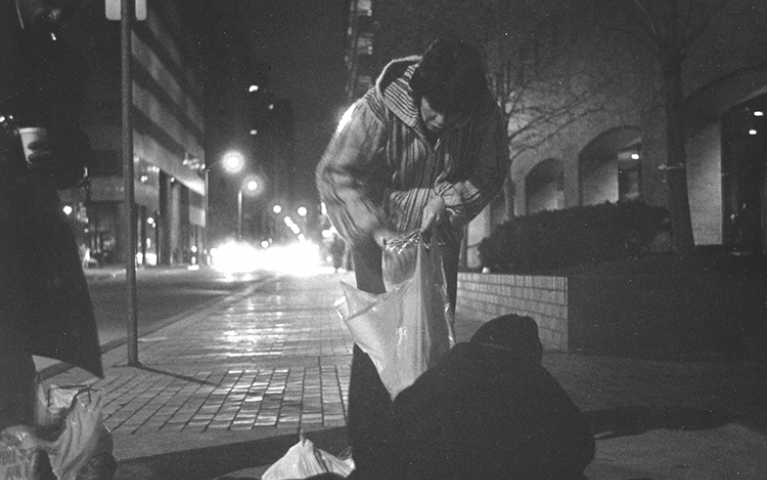State of Homelessness 30 Years On

This story originally appeared in our Winter Edition of News from HOME.
This year marks a phenomenal milestone: the 30th anniversary of Project HOME. Looking back on the early days of building relationships with people on the streets and opening emergency shelters, we see how much has been accomplished: last year, we housed more than one thousand people. Through collaboration over the years, Philadelphia has made substantial progress. Our street counts, though hovering above 900 people in recent years, are the lowest of the nation’s ten largest cities, despite a staggeringly high poverty rate (26 percent, or approximately 400,000 Philadelphians). By comparison, Los Angeles, with three times Philadelphia’s population, has a poverty rate of 18.6 percent and a homeless population of 22,887. Leadership and partnership from people, organizations, and government agencies across the region and country have played a critical role in creating a future of hope for so many.
When we began in 1989, street homelessness among people with serious mental illness seemed an utterly unsolvable problem, a permanent feature of the urban landscape. Today, we are able to talk about ending chronic street homelessness. We have developed proven, cost-effective solutions, and been fortunate to have public and private sector peers and partners who share a vision of a just and compassionate society and do the work daily to make that vision a reality.
From our early days, we focused our efforts on street homelessness, primarily among people with mental illness. Generally, the most visible in Center City, street homelessness was historically a result of poverty, deinstitutionalization and limited mental health care and other social supports, and drug epidemics, paired with ever-increasing housing costs. The widening gap between what people earn on minimum wage or public benefits – once enough to afford housing – and the cost of safe, decent housing has grown into the most intractable cause of homelessness. Today, in collaboration with the city and many spectacular peer organizations, we are working to address homelessness among young adults and homelessness caused by addiction.
Poverty is not the only factor causing homelessness. Mental health and addiction are equal opportunity diseases. Our recent ad campaign, designed to give hope to people living on the streets and struggling to attain recovery, featured Project HOME residents and alumni from all walks of life. Following national trends, substance use is growing in Philadelphia, and the region is facing the greatest public health crisis in decades. The number of deaths related to drug overdose – more than 1,000 in the City last year -- is triple that of the number of homicides. Individuals experiencing homelessness are at an increased risk of substance abuse disorder and drug overdose; this is a risk amplified in Philadelphia given the low cost and high potency of heroin on our streets.
In 2015, Project HOME opened the doors of the Stephen Klein Wellness Center, in the second-poorest zip code in Philadelphia. This beautiful 30,000-square-foot structure is home to an extensive program of trauma-informed health services specifically tailored to the surrounding community, including dental, prenatal, pharmaceutical, physical fitness, behavioral health, recovery, legal and benefits counseling, and programs for community education. As a Federally Qualified Health Center, we are able to offer services to low-income persons lacking ability to pay. Recently, through partnerships with Pathways to Housing PA and Prevention Point, we are able to provide critical healthcare and treatment services to individuals struggling with homelessness and substance use through an innovative model known as Medication Assisted Treatment (MAT). MAT uses a unique combination of behavioral therapy and medications to treat substance use disorders. Robin DeBates, who manages our MAT program, describes it this way: “Because we provide MAT services in an integrated wellness center setting, we have a way to help people engage in and take charge of their physical, mental, and social health. Our goal is to make medication-assisted treatment easier to get than heroin and to stick with them when they show signs of addiction, which is the disease we are helping treat. We continue to hear stories of patients reconnecting with their roles as parents, employees, and functioning community members due to their hard work in recovery plus the support we are able to provide.”
In the coming weeks, we will open a new residence which will prototype further integration of recovery housing with healthcare and employment for people beginning their recovery journey. Sacred Heart Recovery Residence will provide a safe, supportive program with a range of services to assist individuals on the path to recovery, coupled with education, employment, and healthcare supports to help people stably transition to permanent housing.
We remain committed to being the first major city to render homelessness a distant memory. Poverty, addiction, and mental illness are adversaries too daunting for any of us to face alone. Together we can build a brighter future for individuals and families, bringing them HOME with dignity and compassion.